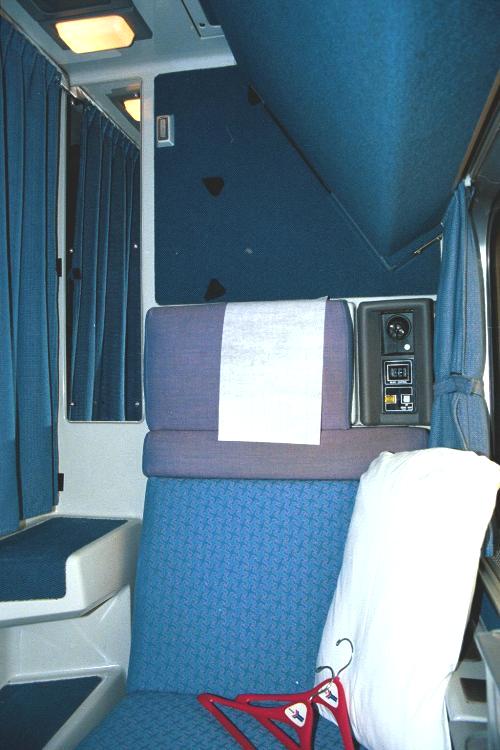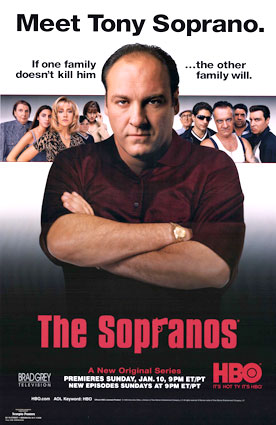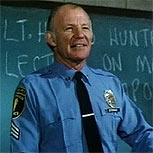I just learned that my flight from Newark will be departing fifty-five minutes late, up from a half-hour when I arrived at the airport. I’m too tired to be irritated, especially since I learned long ago that no matter what may happen along the way, it’s going to take me at least nine hours to get from New York to Smalltown, U.S.A. Getting to the airport from the Upper West Side, flying from the New York area to St. Louis, traveling south by shuttle bus from there to Smalltown…that’s a full day’s travel any way you slice it, and most of it is destined to be wasted.
I can burn off a certain amount of time doing a certain amount of work now that I travel with a wireless-equipped MacBook, but while I’m capable of doing serious writing on a plane or in a departure lounge if absolutely necessary, what comes out in the absence of the spur of necessity tends not to be very good. So more often than not, I spend a significant part of the day standing in lines, looking out airplane windows, and pretending to read.
 Would that it were possible to take a train from New York to Smalltown, but the last passenger train to stop in my hometown pulled out of the station more than forty years ago, and the old depot is now a museum. I love trains, so much so that I took a sleeper from New York to Chicago three years ago just so that I could write about it for The Wall Street Journal. Now that I’m cooling my heels in Newark, it strikes me that you might enjoy reading that piece–I know I would–so here is “Sleepless on the Lake Shore Limited.”
Would that it were possible to take a train from New York to Smalltown, but the last passenger train to stop in my hometown pulled out of the station more than forty years ago, and the old depot is now a museum. I love trains, so much so that I took a sleeper from New York to Chicago three years ago just so that I could write about it for The Wall Street Journal. Now that I’m cooling my heels in Newark, it strikes me that you might enjoy reading that piece–I know I would–so here is “Sleepless on the Lake Shore Limited.”
For the record, the dateline, which I wrote with the utmost pleasure, was Between New York and Chicago.
* * *
I grew up dreaming of long-distance trains. They were in the songs I loved (“I took a trip on a train/And I thought about you”) and the movies I watched (“I tipped the steward $5 to seat you here if you should come in”). Their tracks criss-crossed the main street of the small Missouri town where I spent my childhood, and their braying whistles cleaved the night air as they carried sleeping strangers to places I’d never been.
Alas, the highways and airlines were killing off passenger trains long before I figured out exactly what Cary Grant wanted to do to Eva Marie Saint on the Twentieth Century Limited. By the time I was old enough to travel alone, I took it for granted that I’d never spend a night in a sleeper car, watching the world rumble by. So when the Department of Homeland Security raised America’s alert status from yellow to orange a few days before I had to fly from New York to Chicago to look at plays, it struck me that this might well be my last chance to satisfy a longtime craving. I tore up my plane ticket, paid a visit to www.amtrak.com, booked a Viewliner Standard Bedroom on the Lake Shore Limited, and prepared to find out what I’d been missing all these years.
 Robert Frost once wrote a poem about a songbird whose autumnal task was to tell his listeners “what to make of a diminished thing.” As I laid eyes on the cramped roomette in which I would be spending the next 20 hours, I knew that would be my job as well. A Viewliner Standard Bedroom stuffs two seats, a toilet and a foldaway sink into slightly more than 23 square feet of floor space, about the size of an Upper West Side walk-in closet. If you want a compartment similar in size to the one in which Grant wooed Saint in “North by Northwest,” you’ll have to shell out a lot more. (I paid $684 for my round-trip fare between New York and Chicago, meals included.)
Robert Frost once wrote a poem about a songbird whose autumnal task was to tell his listeners “what to make of a diminished thing.” As I laid eyes on the cramped roomette in which I would be spending the next 20 hours, I knew that would be my job as well. A Viewliner Standard Bedroom stuffs two seats, a toilet and a foldaway sink into slightly more than 23 square feet of floor space, about the size of an Upper West Side walk-in closet. If you want a compartment similar in size to the one in which Grant wooed Saint in “North by Northwest,” you’ll have to shell out a lot more. (I paid $684 for my round-trip fare between New York and Chicago, meals included.)
The train slipped smoothly out of New York’s Penn Station at 2:50 p.m., right on time, and within minutes we had popped out of the tunnel and were rattling northward along the Hudson River. That was when I understood why people still take sleepers. The windows in each compartment are huge, the view transfixing. I scarcely noticed that the compartment itself was shabby and rundown, or that the miniature TV on which Amtrak invited me to view “Seabiscuit” and “Pirates of the Caribbean” was out of order. I’d brought along a laptop, a DVD of “Strangers on a Train” and several books, but I spent every spare minute of daylight gazing out at bleak brown hills, ice-flecked brooks, tiny cemeteries and stations with names like Cold Springs and Breakneck Ridge, all made beautiful beyond imagining by the golden winter sunset.
The red carpets and fresh flowers of yesteryear are long gone, but Amtrak’s cheerful porters do their best to pretend that things are what they used to be, and the dining car still serves its perfectly edible hot meals on china and white linen, seating strangers together in the snug booths. I didn’t run across any footloose Hitchcock blondes, but I did meet a lot of nice fellow travelers, most of whom could be divided into four groups: train buffs, fearful flyers, grumpy Europeans who’d expected something fancier, and senior citizens who’ve been taking the train for a half-century and aren’t about to quit now. Except for the Europeans, all were friendly and talkative.
 The porter made up my hard, narrow berth after dinner. It was so uncomfortable that I barely slept, but I didn’t care. Instead, I looked at the twinkling lights of the small towns of New York, Pennsylvania and Ohio, and as the whistle blew, I thought, I’m riding one of the trains I dreamed about when I was a boy. This is the whistle that made me wonder what the rest of the world was like–and now I know.
The porter made up my hard, narrow berth after dinner. It was so uncomfortable that I barely slept, but I didn’t care. Instead, I looked at the twinkling lights of the small towns of New York, Pennsylvania and Ohio, and as the whistle blew, I thought, I’m riding one of the trains I dreamed about when I was a boy. This is the whistle that made me wonder what the rest of the world was like–and now I know.
We pulled into Union Station an hour late. I caught a cab to the Art Institute of Chicago to see “Manet and the Sea.” The driver sang along with Louis Armstrong and Ella Fitzgerald on the radio, and I sang along with him, unshowered, underslept and glowing with happiness. Train travel may not be what it used to be, and it definitely costs too much to do more than occasionally. But if you want a sweet taste of what America was like in a slower, quieter age, book a bedroom on the Lake Shore Limited. You can always sleep at home.
Archives for 2007
TT: Over the river and through the woods
I’m off to Smalltown, U.S.A., where Mrs. T and my family are waiting impatiently for me.
 I might possibly do a little blogging while I’m gone, but I expect to spend most of my time immersed in family-type holiday activities, especially since I just finished taping two TV segments and writing nine pieces in a row–five Wall Street Journal columns, three Contentions book columns, and a Commentary essay, believe it or not. (Don’t try this at home!)
I might possibly do a little blogging while I’m gone, but I expect to spend most of my time immersed in family-type holiday activities, especially since I just finished taping two TV segments and writing nine pieces in a row–five Wall Street Journal columns, three Contentions book columns, and a Commentary essay, believe it or not. (Don’t try this at home!)
Seeing as how the point of all this frenzied literary activity was not to have to do any writing in Smalltown, it strikes me that to blog from there would be counterproductive. So except for the daily almanac entry and the usual theater-related postings, don’t expect to be hearing too much from me until Mrs. T and I return to New York some time around the turn of the year.
In the meantime, may all your Christmases be bright–and may you spend them in the company of a loving family, traditional or otherwise.
TT: So you want to see a show?
Here’s my list of recommended Broadway and off-Broadway shows, updated weekly. In all cases, I gave these shows favorable reviews in The Wall Street Journal when they opened. For more information, click on the title.
Warning: Broadway shows marked with an asterisk were sold out, or nearly so, last week.
Because of the recently settled stagehands’ strike, many Broadway shows are offering heavily discounted tickets to certain performances. For information, go here.
BROADWAY:
• August: Osage County (drama, R, adult subject matter, closes Mar. 9, reviewed here)
 • Avenue Q (musical, R, adult subject matter and one show-stopping scene of puppet-on-puppet sex, reviewed here)
• Avenue Q (musical, R, adult subject matter and one show-stopping scene of puppet-on-puppet sex, reviewed here)
• A Chorus Line (musical, PG-13/R, adult subject matter, reviewed here)
• The Farnsworth Invention (drama, PG-13, reviewed here)
• Grease * (musical, PG-13, some sexual content, reviewed here)
• Is He Dead? (farce, G, reasonably family-friendly, reviewed here)
• Rock ‘n’ Roll (drama, PG-13, way too complicated for kids, reviewed here)
• The Seafarer (drama, PG-13, adult subject matter, reviewed here)
• The 25th Annual Putnam County Spelling Bee (musical, PG-13, mostly family-friendly but contains a smattering of strong language and a production number about an unwanted erection, closes Jan. 20, reviewed here)
OFF BROADWAY:
• The Fantasticks (musical, G, suitable for children old enough to enjoy a love story, reviewed here)
CLOSING SOON:
• Cymbeline (drama, PG, too complicated for children, closes Jan. 6, reviewed here)
• The Glorious Ones (musical, R, extremely bawdy, closes Jan. 6, reviewed here)
CLOSING NEXT WEEKEND:
• The Drowsy Chaperone (musical, G/PG-13, mild sexual content and a profusion of double entendres, closes Dec. 30, reviewed here)
• Things We Want (drama, R, adult subject matter, closes Dec. 30, reviewed here)
TT: Almanac
So that the reverence and the gaiety
May not be forgotten in later experience,
In the bored habituation, the fatigue, the tedium,
The awareness of death, the consciousness of failure,
Or in the piety of the convert
Which may be tainted with a self-conceit.
T.S. Eliot, “The Cultivation of Christmas Trees”
OGIC: More on Frau
After I posted last week about seeing Chicago Lyric’s splendid production of Richard Strauss’s Die Frau ohne Schatten, Lisa Hirsch, who blogs knowledgeably about such matters at Iron Tongue of Midnight, wrote to me with an assessment of the opera’s plot that is just too brilliant not to be shared:
The plot drives me mad, between the idea that no one can possibly be fulfilled without children and the sheer ponderousness that results from taking “The Magic Flute,” layering on another dozen characters, replacing the Masonic allegories with something Hoffmansthal made up, and carefully cutting out all the wit and humor of the Mozart. Still, the music glitters and thunders, and the Empress’s transformation scene, done well, is one of the great scenes in all opera. But then I have to put my head in my hands during the damned chorus of unborn children–sheesh!
Hahahahaha! So it wasn’t just me.
Lisa was also kind enough to recommend to me some recordings of the opera: this full recording of a Wolfgang Sawallisch production and two cut versions conducted by Karl Bohm and Herbert von Karajan.
OGIC: The Netflix ten
Better late than never, right? It’s been a little more than a week since Terry asked me and Carrie to supply the names of 10 movies released since fall 2005 that we most enjoyed. Carrie weighed in with five of hers here, with impressive annotation to boot. I’m offering mine in a straight-out list, sans commentary, but with the caveat that I’m not entirely sure I’m remembering everything. In no particular order, the top ten are:
1. Friends with Money
2. The Descent*
3. Half Nelson
4. Casino Royale ( great minds)
5. Serenity (ditto)
6. The Lives of Others
7. Once
8. Ratatouille
9. Killer of Sheep
10. No Country for Old Men
I asterisked The Descent because I know Terry won’t like it: it’s a bloody, terrifying horror movie that I happened to like enough to put on this list. Not Terry’s cup of cocoa at all. Some honorable mentions that provided solid entertainment or better are Fracture, Dan in Real Life, Michael Clayton, Sunshine, and The Family Stone. And tomorrow you’ll probably hear about the half dozen movies that I forgot!
Here are ten from that same stretch of time that I want to see:
1. The New World
2. Tristram Shandy
3. Brick
4. Clean
5. United 93
6. The Devil Wears Prada
7. The Science of Sleep
8. The Last King of Scotland
9. The Fountain
10. The Diving Bell and the Butterfly
Like Terry, I’ll be pretty much dark for the extended Christmas. So until next time, happy holidays, one and all.
TT: Still repenting
 Last year I admitted that I’d guessed wrong about the future in an essay called The Myth of “Classic” TV that I wrote for the Sunday New York Times in 2001. In that piece I argued that “there seems to be something in the nature of even the best TV dramas which renders them ephemeral,” meaning that there could be no such thing as a “classic” TV show:
Last year I admitted that I’d guessed wrong about the future in an essay called The Myth of “Classic” TV that I wrote for the Sunday New York Times in 2001. In that piece I argued that “there seems to be something in the nature of even the best TV dramas which renders them ephemeral,” meaning that there could be no such thing as a “classic” TV show:
I can’t tell you how many times I have looked at George Balanchine’s The Four Temperaments, but though I suppose the day may come when it no longer has anything new to say to me, I still find it a source of apparently inexhaustible interest, and try to see it at least once a year. Every art form has produced innumerable masterpieces which, like The Four Temperaments, demand to be experienced repeatedly–every art form, that is, except for series television….
Season-long chunks of TV series like The Sopranos were just beginning to be released on videocassette in 2001, but I predicted that they wouldn’t become popular. Needless to say, the market has proved me wrong, at least in the short run, though I was still arguing as late as last September that “[n]o matter how ‘novel-like’ [a TV show like] Homicide may seem to be, there’s simply too much of it to embrace in the all-absorbing way we embrace a novel.”
True? Let me quote once again from “The Myth of ‘Classic’ TV”:
Hill Street Blues was the first TV drama I ever went out of my way to see, and were there world enough and time, I might even consider watching the first few dozen episodes again. But while I still remember how much I liked Hill Street Blues, I can’t recall much else about it–only a few isolated moments from two or three episodes–whereas I could easily rattle off fairly complete synopses of, say, Citizen Kane or A Midsummer Night’s Dream, or whistle the exposition to the first movement of Mozart’s G Minor Symphony. To qualify as a classic, a work of art must first of all be good enough to make you want to get to know it at least that well. Will any TV series ever be good enough to fill that exalted bill?
 I mention all this because American Life TV, a cable channel of whose existence I only just became aware, is now showing reruns of Hill Street Blues every Sunday. Hill Street Blues was, most TV historians agree, the first hour-long cop show to break with the old-fashioned style of TV drama. Every contemporary series whose plots are arranged in multi-episode “story arcs” and whose characters are photographed with hand-held cameras and portrayed with a combination of tough-minded realism and rough-edged humor is a direct descendant of Hill Street Blues, which I watched faithfully throughout most of its six-year run and thought at the time to be the best TV series ever made.
I mention all this because American Life TV, a cable channel of whose existence I only just became aware, is now showing reruns of Hill Street Blues every Sunday. Hill Street Blues was, most TV historians agree, the first hour-long cop show to break with the old-fashioned style of TV drama. Every contemporary series whose plots are arranged in multi-episode “story arcs” and whose characters are photographed with hand-held cameras and portrayed with a combination of tough-minded realism and rough-edged humor is a direct descendant of Hill Street Blues, which I watched faithfully throughout most of its six-year run and thought at the time to be the best TV series ever made.
“Chipped Beef,” which first aired on December 17, 1981, midway through the second season of Hill Street Blues, was one of the first episodes I saw–maybe even the first. Yet when I sat down to watch it a few weeks ago, I was astonished by how clearly I remembered bits and pieces of the plot, and–more important–by how fresh the show had remained after a quarter-century. I started watching it purely as an experiment, but in minutes I was completely engrossed all over again, and since then I’ve watched two more episodes and liked them even more.
Am I viewing Hill Street Blues through nostalgia-colored bifocals? Probably. I have no doubt whatsoever that part of the appeal it holds for me now is the way in which it reminds me of myself when young. That was half a lifetime ago and half a continent away, back in the days when I lived in a suburb of Kansas City, worked as a teller in an inner-city bank, reviewed concerts at night, played jazz on weekends, and had yet to visit an art gallery or eat a bagel or or meet any of the people who are now my best friends. I don’t know whether the world was simpler then, but my world was both simpler and a good deal more innocent, and it was still possible for me to be pulled up short by a well-written, well-acted TV show whose makers reminded us each week that life is hard and the good guys don’t always win.
 Nowadays I spend too many nights on the aisle to commit myself to theater on the installment plan. Not even The Sopranos was capable of holding my attention over the long haul. When I gave it up midway through its fourth season, I also gave up series TV. Buffy and Gilmore Girls were my last such ventures, and I watched them in batches (courtesy of Our Girl) rather than week by week. But I intend to stick with Hill Street Blues for a little while longer. After all, man cannot live by masterpieces alone, and for now I find that it amuses me to spend the odd hour watching Frank Furillo, Phil Esterhaus, Captain Freedom, and the men and women of Hill Street Station doing battle with the lengthening shadow of urban decay. Even if it isn’t exactly a classic, it definitely beats Law and Order all hollow.
Nowadays I spend too many nights on the aisle to commit myself to theater on the installment plan. Not even The Sopranos was capable of holding my attention over the long haul. When I gave it up midway through its fourth season, I also gave up series TV. Buffy and Gilmore Girls were my last such ventures, and I watched them in batches (courtesy of Our Girl) rather than week by week. But I intend to stick with Hill Street Blues for a little while longer. After all, man cannot live by masterpieces alone, and for now I find that it amuses me to spend the odd hour watching Frank Furillo, Phil Esterhaus, Captain Freedom, and the men and women of Hill Street Station doing battle with the lengthening shadow of urban decay. Even if it isn’t exactly a classic, it definitely beats Law and Order all hollow.
* * *
The first and second seasons of Hill Street Blues are available on DVD, and the first three seasons can also be purchased from iTunes.
TT: Almanac
Call a truce, then, to our labours–let us feast with friends and neighbours,
And be merry as the custom of our caste;
For if “faint and forced the laughter,” and if sadness follow after,
We are richer by one mocking Christmas past.
Rudyard Kipling, “Christmas in India”
